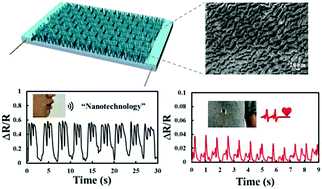Vertical CNT–Ecoflex nanofins for highly linear broad-range-detection wearable strain sensors†
Abstract
Strain sensors with a broad sensing range, high sensitivity and linearity are highly desirable in health monitoring systems to detect both large and subtle strains. However, few strain sensors demonstrate the same high sensitivity at both large strain and subtle strain. In this work, we report a highly linear and broad-range-detection strain sensor by designing a fin-like microstructure, which combines the advantages of vertical carbon nanotubes (CNTs) and Ecoflex. In the proposed structure, most of the vertically grown CNTs are wrapped by polymer to form the CNT–Ecoflex Nanofin (CEN) matrix, while some of the vertical CNTs at the edge of the CEN protrude, like spines on the fin. These exposed CNT spines can effectively improve the sensitivity, especially to small strain. In the CEN structure, the Ecoflex resists the shifting and breaking of CNTs under cyclic strains, which ensures the stretchability and reliability. The unique CEN structure enables the sensor to obtain excellent linearity (R2 > 0.99) under the strain range of 0 to 250% and high sensitivities (from 3 to 18) within a wide sensing range (from 0.1% to 500%). Most importantly, the specification of the strain sensors can be tuned by controlling the lengths and densities of CNTs. These virtues endow the sensor with great application prospects in wearable electronics and health monitoring.



 Please wait while we load your content...
Please wait while we load your content...